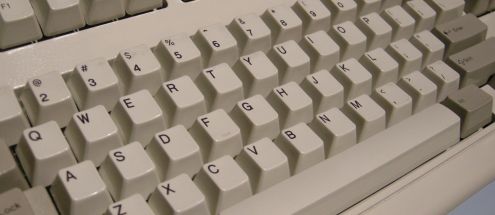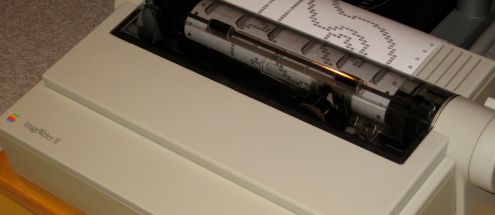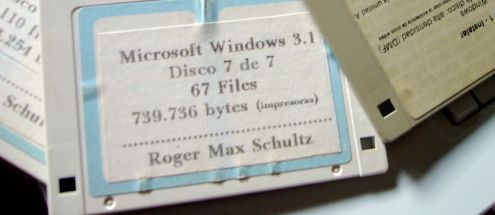It was better in my day: business IT that I miss
It was better in my day: business IT that I miss
Funny thing, nostalgia. It makes you yearn for things from the past, just because you can't have them any more - even though at the time you probably didn't think they were all that.
Of course, in the world of tech, it's only new stuff that's really cool. Just look at the rush to purchase iPad 2 today. Who wants a first generation iPad now?
So, as nostalgia is an underappreciated phenomenon in the world of business IT (and as it's Friday) I've decided to embrace it. Here are the top five pieces of business IT that I miss.
1.The IBM Model M keyboard

Built like the proverbial brick outhouse, these keyboards were first manufactured in the early 80s and I bet most of them are still going today. With a unique 'buckling spring' mechanism, the keys make a tactile click as you type. They're responsive and pleasing to use, and I don't think anybody's ever made a better keyboard.
Heavy enough to crush a substandard desk, solid enough to serve as a battering ram and noisy enough to disrupt a quiet office? Every keyboard should be like this. And, believe it or not, you can buy this keyboard today. IBM sold the manufacturing tools to another company - which still produces them. What other business tech has lasted over 25 years?
2. Computer mice with balls in

These seem to have disappeared from our desks with surprising speed. Yet it's only a few years ago that optical mice - with their fancy light on the bottom - were expensive luxuries that needed special mouse pads to work properly.
I miss the 'rolling over rubbers bands' effect that occurred if you didn't clean your mouse often enough. And I miss the strange pleasure that came from cleaning out the rollers. Where did all that fluff come from? But most of all, I miss being able to steal the ball out of a colleague's mouse and feign ignorance when they discover it missing.
3. Big cathode ray tube monitors

The fitness of your average IT worker must have dropped considerably since most people ditched bulky CRT monitors for flat screens. In a former job I once had to shift some 21" monitors. Those things weigh a ton.
But the thing about them was that you really knew when you had a good monitor. You paid a small fortune for it and lifting it into position frequently took two or three people. Nowadays, you can pick up good, big monitors for pennies.
4. Dot matrix printers

I loved the stacatto noise they made, the ink ribbons that produced prints that got gradually fainter and fainter, and the continuous feed paper that was perfect for printing reams of figures that then had to be trawled and annotated by hand.
I guess the equivalent today is office laser printers which run out of paper, then spit out pages of queued print jobs when someone actually bothers to make the trip to the stationery cupboard.
5. Windows 3.1

Windows 3.1 is the first graphical operating system I can remember using. And while it certainly had its limitations, it was also pretty stable, relatively easy to use - and for many of us, was the first time we were able to swap cumbersome keyboard commands for a mouse and clicks.
Sure, it wasn't the first ever graphical user interface (GUI). But it was the first I used. And that's why it's on this list. (If you want to remind yourself just how Windows 3.1 felt and functioned, here it is recreated in your web browser. Some people have too much time on their hands.)
So, there are the five bits of workhorse business IT that I miss. What are yours? We'll give extra points for particularly esoteric or geeky suggestions.
(Images are all from Flickr users under Creative Commons. Keyboard / jhritz. Mouse ball / L. Marie. Monitor / Collin Anderson. Printer / blakespot. Windows 3.1 / Roger Schultz.)




Comments
I think the main issue for this is that IT Support (http://buff.ly/PBDxXV) is seen as more simple back in those days, but the truth is that now we can support 90% of the problems via remote links over the Internet. Many of the items listed in this article are pre-internet ! I recall trying to get LapLink and PCAnywhere to work over a dial up link and often resorted to giving up and just driving there !
My back problems have significantly decreased since the world made the move from CRT to LCD screens. But I do still miss the satisfying screech that Dot-Matrix printers made!
I don't miss mice with rubber balls at all. There's too much fun to be had with the "post-it note taped under the optical mouse" prank!
Being able to switch between screen colours of Orange and Green! Radical.
And having to save work every 15 minutes as there never was an Undo button.
My mate had a Wang word processor from the mid 1980s. It weighed about the same as a Mini Cooper with all the computing power of a Sinclair ZX81. It took two of us to lift the thing out of his bedsit to take it to the local tip. So, while I may be slightly vexed by the lack of speed, I'm not complaining about the miniaturisation we've seen over the last 20 years.
Dot matrix printers? Pah! I had an Amstrad PCW 8256 word processor with a daisy wheel printer. Loud as hell, but a real step up from my mum's Adler typewriter.
In any look back at old tech, one question always comes up — why aren't things appreciably faster these days? I used to run Quark Xpress (DTP software), Photoshop, Illustrator and MS Office from an 80Mb - 80Mb!! hard disk. Total RAM? 8Mb. Processor speed? 32Mhz. Those capacities are, what, 100 x greater these days? But do we really notice 100 x the difference? I think not. Moore's Law, whereby the power of processors doubles every eighteen months, is countered by IT Sod's Law, where all that extra speed is gobbled up by the less than impressive new features in software.
Add a comment